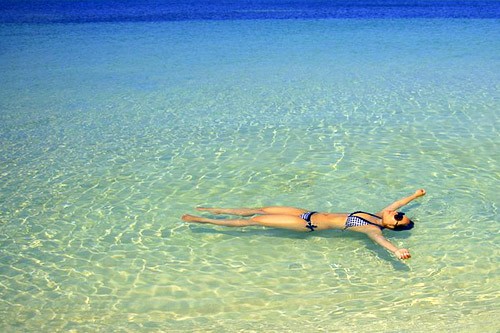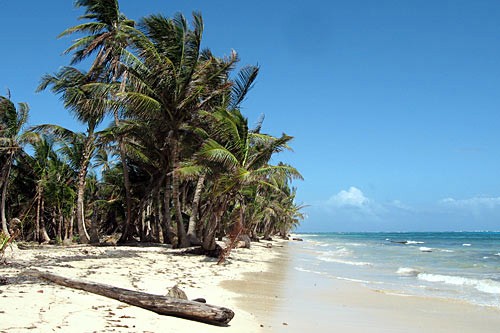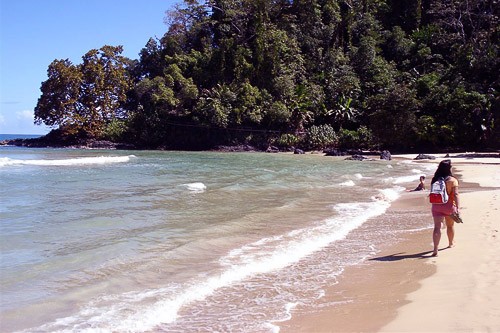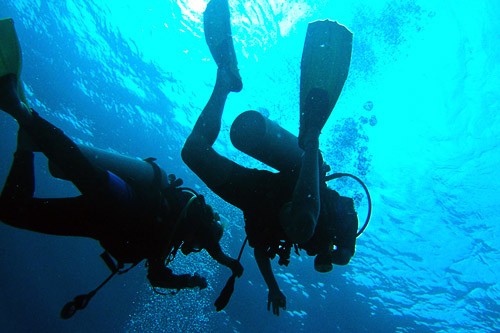Undiscovered Caribbean Islands: Insider's Guide
By
Really Get Away
By Alexis Lipsitz Flippin
This is the Caribbean as it used to be, before cool and luxe stepped in and raised the stakes and the rates. All the physical attributes of the typical Caribbean island are here -- sugary-sand beaches, warm breezes, and sparkling turquoise seas. But 400-thread-count sheets and deconstructed food? Unlikely. High-rise beach boxes and mini-golf? Look elsewhere.
For many of these islands, resort development was stymied for years by political unrest. Many are simply tough to reach. Others have been protected from wanton development by forward-minded regulations or national park designation. All of which is to say, if you love the tropics but prefer a low-key, no-frills barefoot holiday and an authentic Caribbean vibe -- sans the hefty price tag -- the following spots are sure to win you over.
Photo Caption: West Bay Beach in Roatan, Honduras. Photo by stella 781/Frommers.com Community.
This is the Caribbean as it used to be, before cool and luxe stepped in and raised the stakes and the rates. All the physical attributes of the typical Caribbean island are here -- sugary-sand beaches, warm breezes, and sparkling turquoise seas. But 400-thread-count sheets and deconstructed food? Unlikely. High-rise beach boxes and mini-golf? Look elsewhere.
For many of these islands, resort development was stymied for years by political unrest. Many are simply tough to reach. Others have been protected from wanton development by forward-minded regulations or national park designation. All of which is to say, if you love the tropics but prefer a low-key, no-frills barefoot holiday and an authentic Caribbean vibe -- sans the hefty price tag -- the following spots are sure to win you over.
Photo Caption: West Bay Beach in Roatan, Honduras. Photo by stella 781/Frommers.com Community.
Los Roques, Venezuela
The Los Roques national marine reserve archipelago is dotted with hundreds of islets and coral cays set in a necklace of coral reef. Gran Roque is the only island with lodging options, mostly charming, small-scale posadas run by Italian expats. (Regulations prohibit any resort rising higher than two floors.) A day in Los Roques goes something like this: You breakfast at your posada, which then boats you over to an uninhabited cay for the day with a picnic basket of food, a cooler of drinks, and a big umbrella. Or you charter a sailboat or yacht in Gran Roque and dip from one jewel-like cay to another.
More Information: www.los-roques.com.
Photo Caption: View of Los Roques from a propeller plane. Photo by uygsan/Frommers.com Community.
More Information: www.los-roques.com.
Photo Caption: View of Los Roques from a propeller plane. Photo by uygsan/Frommers.com Community.
Corn Islands, Nicaragua
Big and Little Corn Islands are two of the best-kept secrets of the Caribbean. Just 50 miles off the coast of Nicaragua, the Corns represent old-school Caribbean: a laidback (and good-value) tropical vacation amid a pristine marine environment. Little Corn is even more primitive; it's only a square mile in size and has no paved roads and no cars, just lovely white-sand beaches and a tropical-forest interior. Lodging consists of thatched-roof posadas run by European expats.
Photo Caption: The beach side of Little Corn Island, Nicaragua. Photo by snydez00/Frommers.com Community.
Photo Caption: The beach side of Little Corn Island, Nicaragua. Photo by snydez00/Frommers.com Community.
Isla Bastimentos, Panama
Some say Panama is the Costa Rica of 30 years ago. If you're looking for a tropical paradise in a lush and biologically diverse landscape of rain-forest jungles, palm-shaded beaches, and gin-clear seas, head to Bastimentos Marine National Park (Parque Nacional Marino Isla Bastimentos), designated national parkland comprising some 32,700 acres of island, barrier reef, and sea. The park's largest island, Isla Bastimentos, has secluded lagoons, coral gardens, even caves. You stay in eco-lodges where you can watch monkeys swing from the jungle canopy. This is wild, untrammeled territory, with no roads or cars -- you generally move from place to place by boat. No wonder it's called the "Venice of the Caribbean."
More Information: www.islabastimentos.com.
Photo Caption: Red Frog Beach in Isla Bastimentos, Panama. Photo by Tiago Carneiro Machado/Flickr.com.
More Information: www.islabastimentos.com.
Photo Caption: Red Frog Beach in Isla Bastimentos, Panama. Photo by Tiago Carneiro Machado/Flickr.com.
Roatan, Honduras
Hurry up and get to this beautiful tropical island in the Central American Caribbean. Roatan is on the cruise-ship radar, and upscale resorts are lining up to sink their foundations into the stunning beaches. But today, Roatan is the unspoiled Caribbean, a milky-white coastline protected by the second-largest barrier reef in the world and a casual and refreshingly unpolished slice of the tropics. The biggest of the Bay Islands off the Honduran coast, Roatan is a serious dive and snorkel destination, its waters protected as a marine park. It's a bargain, too, for the Caribbean; a seafood dinner goes for around $10. (Make sure the Honduran political scene is stable before you go; check with your government's travel advisories.)
More Information: www.hondurastips.honduras.com.
Photo Caption: Giant tube sponge and a diver in the waters of Roatan, Honduras. Photo by MantaVision/Frommers.com Community.
More Information: www.hondurastips.honduras.com.
Photo Caption: Giant tube sponge and a diver in the waters of Roatan, Honduras. Photo by MantaVision/Frommers.com Community.
San Blas Islands, Panama
Sailors, snorkelers, and Robinson Crusoe wannabes are in thrall to these sparsely inhabited isles. The 365 San Blas islands and cays are unspoiled and should stay that way, despite the fact that CBS's Survivor has already planted its digital footprint nearby. These islands are part of the Kuna Yala nation, an autonomous territory controlled by the indigenous Kuna population. White-sand cays with palm trees and fringing coral reefs are great stopovers for sailors; the islands with Kuna villages offer rustic lodgings, food, and cultural tours.
More Information: www.visitpanama.com.
Photo Caption: One of the many islands in the San Blas region, Panama. Photo by ashleyc/Frommers.com Community.
More Information: www.visitpanama.com.
Photo Caption: One of the many islands in the San Blas region, Panama. Photo by ashleyc/Frommers.com Community.
Turneffe and the Belize Atolls, Belize
Three of the Caribbean's four atolls lie in Belize. The largest is the Turneffe Islands Atoll, made up of some 200 cayes, most of which are uninhabited specks on the ocean. This is a true sportsman's paradise: The vertical wall of the Belize reef makes for excellent diving, and the saltwater flats invite world-class bonefishing. Turneffe and the Belize Atolls are tough to reach and off the beaten path (35 miles from mainland Belize), with a handful of lodges.
More Information: www.travelbelize.org.
Photo Caption: Scuba diving at the Turneffe Atoll, Belize. Photo by Ryan Kenner/Frommers.com Community.
More Information: www.travelbelize.org.
Photo Caption: Scuba diving at the Turneffe Atoll, Belize. Photo by Ryan Kenner/Frommers.com Community.
Isla Holbox, Mexico
It's just a 3-hour drive from Cancún, but Holbox (pronounced "hohl-bosh") is a little easier to reach from the Yucatán side. Holbox was a half-deserted fishing village before tourists discovered it for its beach of finely textured sand. It's most popular in the summer, when more than a hundred whale sharks congregate in nearby waters to feed on the plankton and krill churned up by the collision of Gulf and Caribbean waters. Diving, snorkeling, sportfishing, and tours of Laguna Yalahu, the shallow lagoon separating Holbox from the mainland, are the other main pursuits in this quite corner of the world.













